

The weather! As I sit writing this week's Journal the Sun is trying to break through a very grey sky. I suspect the grey will win the battle over the sun and before long we will be subjected to yet more rain.
Planting new orchards which was on many growers work schedule for December is still not underway. Talking to a grower this week with 15,000 trees to plant, he grinned ruefully before speculating a possible start next week. The trouble is, just as conditions are getting close to acceptable, it rains yet again!
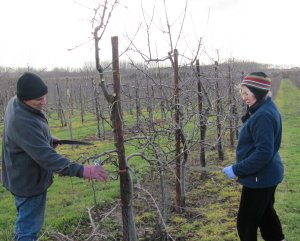
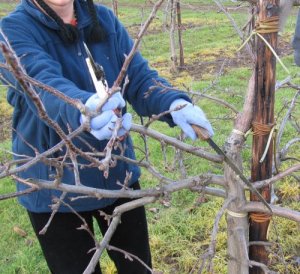
Pruning is progressing steadily and I even managed some time in the garden of a fellow resident of my village, making a start on a couple of well established trees untouched by a pruner for 6 years. Fortunately the previous pruner had at least left the trees in a reasonable shape.
The trees are probably 25-30 years old. Variety I have yet to determine, but my friend said they crop very well. I await with interest the opportunity to examine the trees in summer when the fruit will confirm to me the varieties.
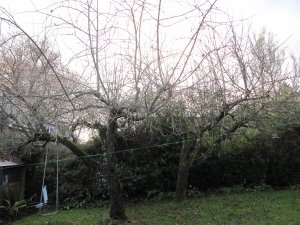 The trees are open centre standard format; e.g. traditional garden trees, with a 6 foot trunk and 3-4 main branches so the basic shape is good. Remedial pruning is so much easier if the tree has been set out correctly in it's formative years. When a tree is left unpruned for a period of several years the water shoots (we call them suckers) grow rapidly towards the sun. After 6 years these trees have a proliferation of upright growth;' mini trees' in the top of trees, out of reach of all but the longest ladders and more importantly stealing the light from the more accessible branches below.
The trees are open centre standard format; e.g. traditional garden trees, with a 6 foot trunk and 3-4 main branches so the basic shape is good. Remedial pruning is so much easier if the tree has been set out correctly in it's formative years. When a tree is left unpruned for a period of several years the water shoots (we call them suckers) grow rapidly towards the sun. After 6 years these trees have a proliferation of upright growth;' mini trees' in the top of trees, out of reach of all but the longest ladders and more importantly stealing the light from the more accessible branches below.
My first task was to remove the uprights, opening the rest of the tree to more light.
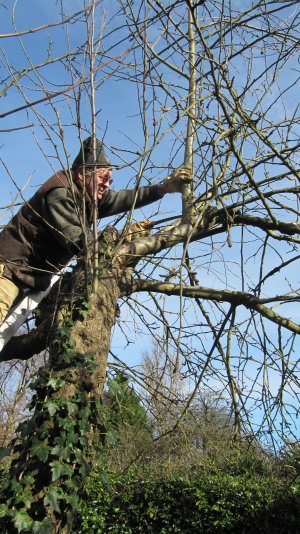
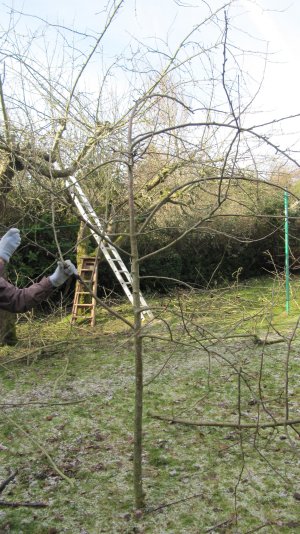
Once this task is complete the remaining branches require thinning out and where necessary 'setting up' the lower branches to allow reasonable access below; in a garden situation this gives room to mow and freedom for the children to play unhindered.
This action mirrors older commercial orchards where machinery access is/was important.
"There are very few commercial orchards where this is applicable today. Most will be of an intensive/semi intensive format"
I will report on the ongoing work in the weeks ahead.
Gala & Braeburn are the two varieties most heavily planted in recent years in English orchards, driving the resurgence of the English Apple industry. They can also be grown very well in the garden and do not need to be physically large trees to deliver a worthwhile crop. Both have an inherent habit of regular cropping, unlike Cox which is much more tempremental in inclement weather conditions. Both varieties benefit from the genetic influence of heavy cropping in their ancestry. Gala replicates Golden Delicious. It is very easy to grow with wide angled branches allowing easy establishment of the base branches and due to it's ability to crop on one year wood as well as the spurs on older wood it has a clear yield advantage over Cox.
Braeburn crops even heavier then Gala. Like many varieties it can be slow to grow away in the first year in the orchard. However it will grow rapidly and crop abundantly from the second year. By the time it is 4-5 years old it will be dripping with apples. Of course both varieties cannot be left to their own devices if yield and quality are to be optimised in the years ahead.
Starting with a well feathered maiden tree identify the feathers suitable as the key base branches, remove any below the optimum height (waist height) and any dominant upright shoots, (see example) then shorten the key feathers by approximately 1/3 cutting back to an outside bud. This strengthens these base branches assisting in establishing a table framework which is where most of the future yield will be.
Pruning the centre leader is a debatable point! Many growers will also head back the leader by 1/3 however this stimulates more vegative growth in the leader and I prefer to leave the leader unpruned allowing it to develop fruit bud rather than vegative growth as it progresses to its full height. (7-8 feet) As the tree develops select suitable lateral growth on the table branches; not weak or strong wood, ideally selecting pencil thick wood growing at just above horizontal which will develop fruit bud and increase the area of cropping wood on the main cropping area; e.g. table branches. Do NOT leave strong upright wood.
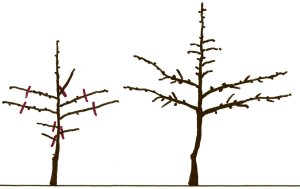
This variety has a tendency to make minimal growth in its first year in the orchard, but the feathers will produce flower bud in the second season and apples (if allowed to stay) will put great weight on the young branches, weighing them down and removing the vigour from the branch. This will result in new growth forming in areas not conducive to ideal tree shape. I prefer to support the chosen base branches by tying them up (in the spring of year 2) to just above horizontal, the branches will then strengthen and establish as good fruit bearing units. In many new commercial orchards this support is achieved with a tee bar and wire to stop the main branches drooping and losing vigour. Once established these table branches will develop abundant fruit bud and set heavy crops.
As the centre leader develops, lateral shoots will become fruiting units. Maintaining balance depends on removing these lateral branches when they become too strong; when the thickness of a branch exceeds half the thickness of the trunk, it is time to remove it. If the cut is made correctly a new shoot will grow in it's place. The cycle of replacement wood will continue throughout the life of the tree maintaining the centre leader as a fruiting unit without allowing any shading of the main cropping area below. If these lateral branches are kept too long the fruit distribution yield and quality will suffer, as shading is detrimental to the fruiting wood on the table branches below.
I have made strong reference to the balance between the table branches and centre leader. This is important and equates with the standard garden tree where the strong upright branches steal the light from the main cropping area below. There is always a temptation to allow the top of a tree to 'overdevelop' as the fruit is always well coloured and generally good size. This temptation has existed since man first cultivated apple trees; my father, an experienced grower, but still capable of succumbing to the attraction of a beautiful branch, albiet in the wrong place but with eye watering prospects of maybe 20lbs of nice apples would wince when I cut it out.
The rule of thumb on a modern centre leader tree is for 85% of the crop on the table branches and 15% on the centre leader for optimum yield and quality. It was really no different on the old traditional systems demonstrated by the garden tree I described above, except that the demand for apples with optimum size, colour, appearance and eating quality have rocketed in the last 25-30 years.
Until next week
The English Apple Man
PS - The Sun did win over the grey skies after all. I wish you a sunny and enjoyable weekend